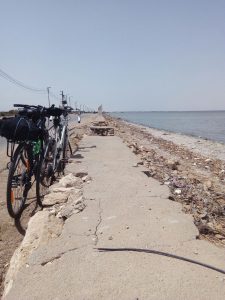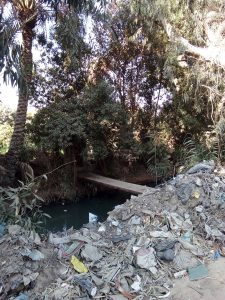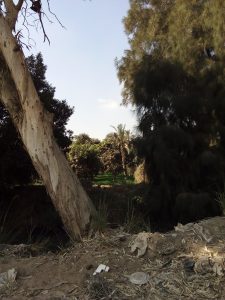.بدأَت تتزايد حملاتِ التنظيف الشواطئ الجميلةِ التي تشتهرُ بها مصر ولتوعيةِ الناسِ بأهمية حماية البيئة
منعَ محافظ البحرَ الأحمرَ استخدام الأكياس البلاستيكية في محافظته، التي تستقبلُ الكثيرُ من السائحينَ الأجانب بسببِ منتجعاتِها الصيفية، من أجلِ حمايةِ أنواعِ الحيوانات المهددةِ بالانقراض
.كما وأطلقَت مجموعةُ من الشبابِ في محافظة شمال سيناء مبادرةٍ مشابهةٍ هدفُها نظافةُ الشاطئ وجعله صحيًا
.رغم ما سبق، فبيئة مصر، بإعتقادي، في حاجة إلى نشاط على مدى أكبرَ من هذا
من جهة أخرى، كانت بحيرةُ المنزلة مركزًا للحياةِ في الدلتا فيما مضى. تطلُ البحيرةُ على البحرَ الأبيض المتوسطَ شمالًا ومحافظة دمياط غربًا، ومحافظتا الشرقية والدقهلية جنوبًا. كما وتحدُها على الشاطىءِ الشرقي محافظة بور سعيد. كانت البحيرة تنتجُ ما يقرب من ٤٠ في المائة من الإنتاج السمكي للبحيرات الطبيعية في مصر. واعتمدَ عليها الصيادونَ للصيد، والمزارعونَ للري. واعتادت أن تحصل المنطقةُ بأكملها على المواد الغذائية والمياه العذبة منها
على رغم من أنَّ جزءً من بحيرة المنزلة مازال محميةً طبيعيةً بشكلٍ رسمي، فلقد تسربَت إليها الكثيرُ من المخلفات الصناعية والزرعية، بالأضافة لمياه الصرف الصحي، مما جعلها تصبح ملوثةً جدًا، وبيئة غير مناسبة لانوعِ فاخرةِ من الاسماك، مثل الدنيس والقروص
ليسَت الحكومة المصرية جاهلةً بالمأساةِ البيئيةِ هذه، وإنها تنفذ مشروعًا لتنظيف المنطقةِ وتبني محطةً معالجة لمياه بحر البقر ومسارًا ضخمًا لتوصيل المياه الناتجة من هذه المحطة من الدلتا إلى سيناء، حيث سوف تستخدم المياه من جديد بدلًا من التخلص منها في بحيرة المنزلة. وبجانب هذه الحملة، فوزارة الداخلية تطبق حملاتها الأمنية بالتعاون مع الأجهزة الإدارية والمعنية في تطوير ورفع كفاءة البحيرة. كما وأعلنت الوزارة الشهر الجاري (اغسطس/آب ٢٠١٩) عن ضبطها ٢٠ قضية عدم تجديد رخصة صيد، بالإضافة إلى إزالة المعدات التي وضعت على البحيرة بشكل غير قانوني، كما وتم تكثيف التواجد الأمني حولها
لكن يتعرضَ هذا النهجُ مع حقيقةِ التحدياتِ في بحيرة المنزلة. فبينما تعالج الحكومةُ المخلفاتِ الزرعيةِ والصرفَ الصحي عبر مسارِ بحر البقر، وتحدُّ الصيدَ المفرطِ عبر اعتقال الصيادين، ليسَ من اليقين أنَّ اثار هذه المشكلتين على الثورةِ السمكيةِ هي بنفس القدر مثل المخلفات الصناعية. رفعَ خالد ابو طالب، عضو مجلس النواب، قضيةَ “تي سي أي سانمار”، أحد المصانعَ في المنطقة الصناعية في محافظة بور سعيد. حيث تورطَ مصنع “تي سي اي سانمار” في قضية بشأن تخلص المصنع من مستويات عالية من المواد الكيميائية الخطيرة في البحيرة في عام ٢٠١٧. قالَ النائب أنَّ كميةَ الصرفِ الصناعي تبلغُ مليون ونصف متر مكعب يوميًا من مصنعةِ تي سي أي سانمار فقط، بالإضافة إلى خمسة مصانع أخرى. وأردفَ بأنَّ لهذا تأثير سلبي كبير على الثروة السمكية في البحيرة
ولقد أجرى العلماءُ في السنواتِ السابقةِ بحوثًا أثبتت بأنَّ مستويات الزرنيخ وعنصر السلينيوم والصفيح في البحيرة بلغت حدًا خطرًا. وهو ما يبيّن مدى توسع نشاط الصناعة في بورسعيد ودمياط
من جهتها، تتعاون الحكومةُ المصرية مع شركةِ هولنديةِ من أجل بناءِ محطةٍ من المخطط أن تعالج ٦٠٠ الف متر مكعب من مواد الصرف الصناعي يوميًا بحلول عام ٢٠٢٠، لكن يظل هنالك حاجة إلى حل أكثر شمولية بشكل ملح
سأنهي مقالي هذا بجملة نشرت على صفحة “بحيرة منزلة” على موقع التواصل الاجتماعي “Facebook”: “لا قيمة لمشروع التطهير والتطوير إن
لم يطبق على القوي قبل الضعيف. لا قيمة لهذا المشروع الضخم اذا لم يطبق على الجميع”

I’ve visited a few of Egypt’s lakes and waterways and the effects of pollution are often very visible
Campaigns have begun to spread across Egypt, pushing to clean the beaches for which the country is so remarkable, and to raise awareness about the importance of protecting the environment.
In a step to protect endangered marine species for example, the use of plastic bags has been banned in the Red Sea governorate, where thousands of foreign tourists flock during summer.
Likewise, a group of young people in North Sinai have begun an ecological initiative to clean up the beaches near Arish.
Despite this, the country is in need of environmental work on a much broader scope.

Just inland of the Mediterranean Sea lies Lake Manzala: once an environmental gem in Egypt’s Delta region. Overlooking Damietta on the west, Sharqiya and Dakahlia southward and bordered on the east by Port Said, it used to provide a focal point for inhabitants of the four governorates. It contributed around 40 percent of the natural lakes’ total fish product, and those working in the farming and fishing sectors were completely dependant on it as a source of clean, natural water, as were inhabitants of the region who got food and water for domestic purposes from the lake.
Even though part of the lake is even officially protected for its natural beauty, industrial and agricultural waste have seeped into the lake over the years, as has sewage from across Egypt. The lake has become brackish and stagnant, and uninhabitable to various rich fish species that used to be common there, including gilt-head bream and sea bass.
The Egyptian government is not blind to the environmental crisis brewing at Lake Manzala, and has begun a project to clean up the area. A treatment plant is being built for water coming from the huge Bahr al Baqr drainage system, which collects sewage and agricultural waste from Upper Egypt all the way northward across the Delta to Port Said, and empties it into the lake. A pipe will transfer the treated water to be reused in the drier governorates of Sinai on the other side of the Suez canal. The Interior Ministry is running a campaign in tandem with other bodies aiming to restore the lake to its former glory, and announced in August that it had checked 20 cases involving people who had not renewed their fishing licenses, and removed “infringements” on the lake, normally buildings, structures or equipment placed around it without official documentation. There is also a stronger security presence around the lake in general.

Yet this approach does not necessarily get to the heart of the problem at Lake Manzala. The government is focusing on sewage and agricultural output, and preventing overfishing by arresting those without licenses; yet these do not affect the lake to the same extent as the industrial waste which continues to pour into it. Khaled Abu Taleb MP raised a point in the House of Representatives during July regarding the TCI Sanmar factory which has been implicated in court during 2017 on charges of disposing of waste containing dangerous levels of toxic chemicals directly into the lake. The waste product is as much as 1.5 million m3 of contaminated water per day from TCI Sanmar alone, said Abu Taleb, adding his concern that there are another five factories in the same industrial zone.
Scientists have conducted research over the past 10 years showing that levels of arsenic, selenium and tin reached dangerous levels, demonstrating the extent of damage caused by industrial activity in Port Said and Damietta.
While the government has teamed up with a company from the Netherlands to build a plant treating 600,000 thousand m3/day of industrial waste by 2020, there is an urgent need for a more comprehensive solution.
While it is encouraging to see awareness growing and citizen-led campaigns directed toward the environment, those working in fishing in Port Said have long protested the importance of protecting Lake Manzala. A post on the “Lake Manzala” Facebook page voices a public desire for those working in large-scale industry to be held accountable. It reads, “There is no value in the project to clean and develop the lake if it fails to address the strong as well as the weak. The vast project is useless, unless it applies to everyone.”
